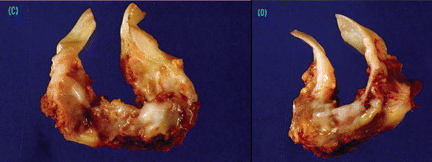Trivia: Do Unicuspid Aortic Heart Valves Really Exist?
By Adam Pick on December 18, 2008
One of the most common, congenital heart valve disorders is a bicuspid aortic valve. Patients born with a bicuspid aortic valve have only two leaflets. Normal aortic valves have three leaflets. Ultimately, this can significantly compromise blood flow through the heart and body as the valve tissue degenerates (stenosis, regurgitation).
Earlier today, I received an email from Nikki. I perked up in my chair as I read her email about a unicuspid aortic heart valve.
Nikki writes to me, “Hi Adam – I am trying to find out more about my 2-year old heart’s condition when I came across your site. He has been diagnosed to have a unicuspid aortic heart valve. At what age will this start to effect him? Do you have any additional info on this? Greetings from Cape Town, South Africa! Nikki (Mom)”

You can see what a unicuspid aortic valve looks like in the pictures above. Notice that there is a single cusp which has been severed at the top of the valve. Both of these removed valves were severely calcified.
Unicuspid heart valves are very, very, very rare. In my research, I did not locate any clinical datasets which tracked the disorder and its impact upon patients (by age, by sex, etc.). However, I did find a few, surgical case studies of aortic valve replacement patients at 26 and 52 years of life. That said, it appears that this disorder can trigger heart valve disease at different times in the patient’s life.
I hope this helps explain more about unicuspid aortic valves.
Keep on tickin!
Adam
|
Jean says on December 18th, 2008 at 10:58 pm |
|
Dear Adam, |
 |
|
nancy mallinger says on December 19th, 2008 at 9:30 pm |
|
I had aortic valve replacement 5 weeks ago at the Cleveland Clinic. What they suspected was a bicuspid valve actually turned out to be unicuspid. I didn’t realize that was so rare. |
 |
|
JANET COYLE says on December 21st, 2008 at 1:02 pm |
|
I have had three pleural effusions since my aortic replacement on Oct 30th. |
 |
|
KRIS PINN says on February 24th, 2009 at 9:36 pm |
|
DEAR ADAM, I JUST UNDERWENT WHAT I THOUGHT WAS A BICUSPID VALVE REPLACEMENT. DURING SURGERY IT WAS IDENTIFIED AS A UNICUSPID. I AM 40 YRS OLD HAVE THREE CHILDRED AND LIVE A ACTIVE LIFE. I WANTED TO LET NIKKI KNOW THAT AS LONG AS YOU WATCH IT EVERY YEAR WITH A CARDIOLOGIST HER CHILD WILL LIVE A GOOD LIFE |
 |
|
Scott H says on June 1st, 2009 at 8:31 pm |
|
Hello Everyone — Nikki … I played Varsity Soccer, Varisty Tennis, Swimming, and Basketball. Your son will be fine, but trust me he will have a different appreciation for life then you can imagine! I am currently only on a Beta-Blocker and low dose aspirin. If you have any questions feel free to contact me at ko37784@gmail.com Thanks. Scott H |
 |
|
Carla says on July 16th, 2009 at 2:08 pm |
|
Hi Nikki and Adam, I am the parent of a 17 year old son. He was diagnosed with bicuspid aortic stenosis when he was one year old. We were told he probably wouldn’t need surgery until he was 30 or 40. He was fine with a normal childhood until he turned 15, when he started having rapid heart beat. I knew then things were changing for him. When he was 16, he started having chest pains. We were told he needed surgery soon. He had open heart surgery one week later. Last August, at age 16, he underwent aortic valve replacement surgery in which he received an artificial valve. I chose the artificial valve hoping he would not need another surgery later in life. During the operation they found he actually was unicuspid, but the way the valve moved on the echocardiogram it looked as though it was bicuspid. The surgeon said we were lucky we chose not to wait awhile for the surgery. My son recovered quickly from surgery and is doing great. He is a typical high school student and will be a senior this year. I just wanted to let you know that it’s been almost a year since my son’s surgery and he has a great, healthy future ahead of him. Good luck with you and your son. |
 |
|
Andy Rao says on February 19th, 2010 at 3:31 pm |
|
Hi Adam, |
 |
|
Thomas Sims says on February 19th, 2010 at 3:32 pm |
|
On December 4th 2009 I had aortic valve replacement that was severtly calcified went home four days later, after three days at home I had A Fib back to the hospital for four more days. |
 |
|
Stephanie says on June 17th, 2011 at 1:40 am |
|
My husband has a unicuspid valve which was just identified. It is believed he had a heart attack at the age of 9. He had a heart cath at that time during which he was tied to a table and the anesthesia didn’t work! He was traumatized and made it till 38 and now cannot go any longer without a valve replacement. He says, however, that he has had pain all his life. In the past year he deteriorated so fast…eventually his job said he could not return until the problem was solved and he gave in to the surgery. Luckily medicine has changed since then and he realizes that! I think everyone is different. He has severe stenosis, moderate regurgitation and has delevoped a small aortic aneurysm at the root. He also has problems tolerating heat (when he was VERY young he broke out in a rash when he was in direct sunlight), he has early onset arthritis (started in his 20’s)in most joints, mild scoliosis in the mid-back and a very large chest. I’m sure such a rare thing is probably related to these other rare things…I just don’t know how. I think if he had done the procedure sooner he would have been better off. His doctor had reccomended 20 at the latest when they left opted not to proceed with surgery as a child. He was just too scared. He never went back to a single doctor unless he was deathly ill until about 3 years ago. |
 |
|
Suzanne Johnson says on September 28th, 2011 at 10:26 pm |
|
I was diagnosed with a bicuspid aortic valve in 1990, when I was 43 years old. We had moved to Minnesota by Rochester, so I needed a new doctor and went to the Mayo clinic. The doctor said I had a world class heart murmur and scheduled an echocardiogram, which showed a bicuspid aortic valve. I had had irregular heart beats for years and shortness of breath. The doctors watched me for 7 years and in 1997, I had the valve replacement and that’s when they discovered that the valve was actually unicuspid. I have a St. Jude’s mechanical valve, and the biggest drawback has been taking warfarin and the dietary restrictions and blood work. |
 |
|
Jaimie says on December 15th, 2011 at 5:11 pm |
|
My son was born with an unicupid aortic valve requiring heart surgery at 1 day old, 3 months old and 5 months old. He is now 4 and we are getting ready to have a ROSS procedure done. I wish there was more information about this congenital defect as I am told this happens about 1 in every 200,000 babies. He would not have lived long if this was not caught right after his birth. |
 |
|
Michael says on December 5th, 2012 at 8:12 pm |
|
Hello, |
 |
|
Suzanne says on December 5th, 2012 at 8:37 pm |
|
I too have had valve replacement. In 1997 at age 50 I had a St. Jude’s valve replacement for a unicuspid valve. The doctors thought it was a bicuspid valve until the actual surgery. The worst part is the blood thinners and having to stop and start them before and after procedures and surgeries. |
 |
|
Hayley says on October 11th, 2013 at 7:55 am |
|
I am a mother of a 21 year old son who was diagnosed with bicuspid valve aged 1. We were told that he would need surgery as he got older to strech the valve as there was considerate narrowing. Year after year we were told he did not need to have this done ‘just yet’ until 20th August 2012 when he suffered a cardiac arrest aged 20. Without the quick intervention of some amazing people my son would not be here today. He spend 5 weeks in hospital and underwent open heart surgery where they have stretched the valve due to the aorta having bottle necked due to the pressure and has also had as defibrilator fitted just in case of reoccurance. We have this week seen a ‘new’ consultant who advises that my son actually has ‘unicuspid valve and showed us echos pre cardiac arrest. He will now have to go back to have open heart surgery to replace the valve which in my eyes should have been when they opened him up last year. As I am sure you will appreciate this is too much to absorb for such a young man and for us his family. I am writing this as I am frustrated and upset and wish that I could take my sons place. If anyone has any advice or can just be an ear that would be gratefully appreciated. |
 |
|
Chloe says on April 23rd, 2014 at 4:28 am |
|
My daughter was born with an ascending aortic aneurysm and what we learned over time was an unicuspid aortic valve. She is 5 and her issues have stabilized since she started taking Losartan. Up until age 3 it was more bad news at every appointment. Since starting the meds 2 years ago, she’s doing great! |
 |
|
Katann says on May 20th, 2014 at 1:36 pm |
|
Hi! Uni-cuspid Aortic Valve is extremely rare! My doctor told me that only 0.2% of the entire population have this rare disorder. I am one of them. I was also told about 20 years ago that I would eventually have to have the valve replaced with a mechanical valve or pig’s valve. I just turned 60 in March and I have the heart tests and scans done yearly to check to see if the valve is narrowing. For the past 5 years, mine has remained the same. The nuclear heart tests that I did last week shows my heart muscle is strong and working well. No narrowing and excellent blood flow. My doctor says that I may never have to have the valve replaced, but there is that chance that I will. I will never be prepared for open heart surgery, so I pray that I never have to. Nurses and doctors love to hear my murmured heart beat. They always tell me that I am every medical students dream to get to hear my heart. It is such a rarity that they will most likely never get to hear one. It just goes to show that even with one flap on the heart instead of the normal three, you can still live a good life. |
 |












